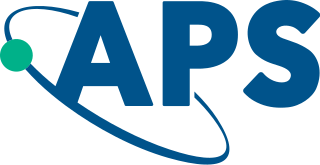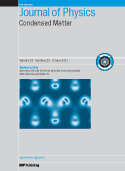
The American Physical Society (APS) is a not-for-profit membership organization of professionals in physics and related disciplines, comprising nearly fifty divisions, sections, and other units. Its mission is the advancement and diffusion of knowledge of physics. The society publishes more than a dozen scientific journals, including the prestigious Physical Review and Physical Review Letters, and organizes more than twenty science meetings each year. APS is a member society of the American Institute of Physics. Since January 2021 the organization has been led by chief executive officer Jonathan Bagger.
Physical Review is a peer-reviewed scientific journal established in 1893 by Edward Nichols. It publishes original research as well as scientific and literature reviews on all aspects of physics. It is published by the American Physical Society (APS). The journal is in its third series, and is split in several sub-journals each covering a particular field of physics. It has a sister journal, Physical Review Letters, which publishes shorter articles of broader interest.
Physical Review Letters (PRL), established in 1958, is a peer-reviewed, scientific journal that is published 52 times per year by the American Physical Society. As also confirmed by various measurement standards, which include the Journal Citation Reports impact factor and the journal h-index proposed by Google Scholar, many physicists and other scientists consider Physical Review Letters to be one of the most prestigious journals in the field of physics.

Advances in Physics is a bimonthly scientific journal published by Taylor & Francis that was established in 1952. The journal is also issued as a supplement to the Philosophical Magazine. Peer review is determined on a case-by-case basis. The editors-in-chief are Paolo Radaelli and Joerg Schmalian.

Volker Heine FRS is a New Zealand / British physicist. He is married to Daphne and they have three children. Volker Heine is considered a pioneer of theoretical and computational studies of the electronic structure of solids and liquids and the determination of physical properties derived from it.
The Journal of Physics B: Atomic, Molecular and Optical Physics is a biweekly peer-reviewed scientific journal published by IOP Publishing. It was established in 1968 from the division of the earlier title, Proceedings of the Physical Society. In 2006, the Journal of Optics B: Quantum and Semiclassical Optics was merged with the Journal of Physics B. The editor-in-chief is Marc Vrakking.
The Journal of Physics A: Mathematical and Theoretical is a peer-reviewed scientific journal published by IOP Publishing, the publishing branch of the Institute of Physics. It is part of the Journal of Physics series and covers theoretical physics focusing on sophisticated mathematical and computational techniques.

Journal of the Physical Society of Japan (JPSJ) is a monthly, peer-reviewed, scientific journal published by the Physical Society of Japan (JPS). It was first published in July 1946. The editor-in-chief was A. Kawabata until August 2010. The impact factor for JPSJ in 2017 is 1.485, according to Journal Citation Reports.

Journal of Physics: Condensed Matter is a weekly peer-reviewed scientific journal established in 1989 and published by IOP Publishing. The journal covers all areas of condensed matter physics including soft matter and nanostructures. The editor-in-chief is Gianfranco Pacchioni.
Luciano Pietronero is an Italian physicist and full professor at the department of Physics at the Sapienza University of Rome. He is also Director of the Institute of Complex Systems of the National Research Council.
Physical Review E is a peer-reviewed, scientific journal, published monthly by the American Physical Society. The main field of interest is collective phenomena of many-body systems. It is currently edited by Uwe C. Täuber. While original research content requires subscription, editorials, news, and other non-research content is openly accessible.

Nature Physics is a monthly peer-reviewed scientific journal published by Nature Portfolio. It was first published in October 2005. The chief editor is Andrea Taroni, who is a full-time professional editor employed by this journal.
Physical Review A is a monthly peer-reviewed scientific journal published by the American Physical Society covering atomic, molecular, and optical physics and quantum information. As of 2021 the editor was Jan M. Rost.

PhysChemComm was a peer-reviewed scientific journal that was published by the Royal Society of Chemistry between 1998 and 2003. It covered all aspects of physical chemistry and chemical physics, and their interfaces with condensed matter, physics and biological, materials and surface science. The journal was abstracted and indexed in Chemical Abstracts Service and Scopus. According to the Journal Citation Reports, the journal's last impact factor of 1.500 was issued in 2005.
The Journal of the Korean Physical Society is a peer-reviewed scientific journal published by Springer Science+Business Media on behalf of the Korean Physical Society. The journal publishes 24 issues per year and past issues from 1968 to 2011 are available as open access. The editor-in-chief is Kong-Ju-Bock Lee. The journal covers original research in all areas of physics. For example, coverage encompasses statistical physics, condensed matter physics and particle physics. Publishing formats include regular full papers, letters, and brief sections. Editors choose featured articles for the journal.
Materials Chemistry and Physics is a peer-reviewed scientific journal published 18 times per year by Elsevier. The focus of the journal is interrelationships among structure, properties, processing and performance of materials. It covers conventional and advanced materials. Publishing formats are short communications, full-length papers and feature articles. The editors-in-chief are Sam Lap Ip Chan and Kwang Lung Lin.

Laurens W. Molenkamp is a professor of physics and Chair of Experimental Physics at the University of Würzburg. He is known for his work on semiconductor structures and topological insulators.
Stephen E. Nagler is a Canadian condensed matter and materials science physicist. Nagler is the Corporate Research Fellow of the Oak Ridge National Laboratory (ORNL) and the Director of the laboratory's Quantum Condensed Matter Division. He is an adjunct professor with the Department of Physics at the University of Tennessee.
Eugene John "Gene" Mele is a professor of physics at the University of Pennsylvania, where he researches quantum electric phenomena in condensed matter.

Randall David Kamien is a theoretical condensed matter physicist specializing in the physics of liquid crystals and is the Vicki and William Abrams Professor in the Natural Sciences at the University of Pennsylvania.









